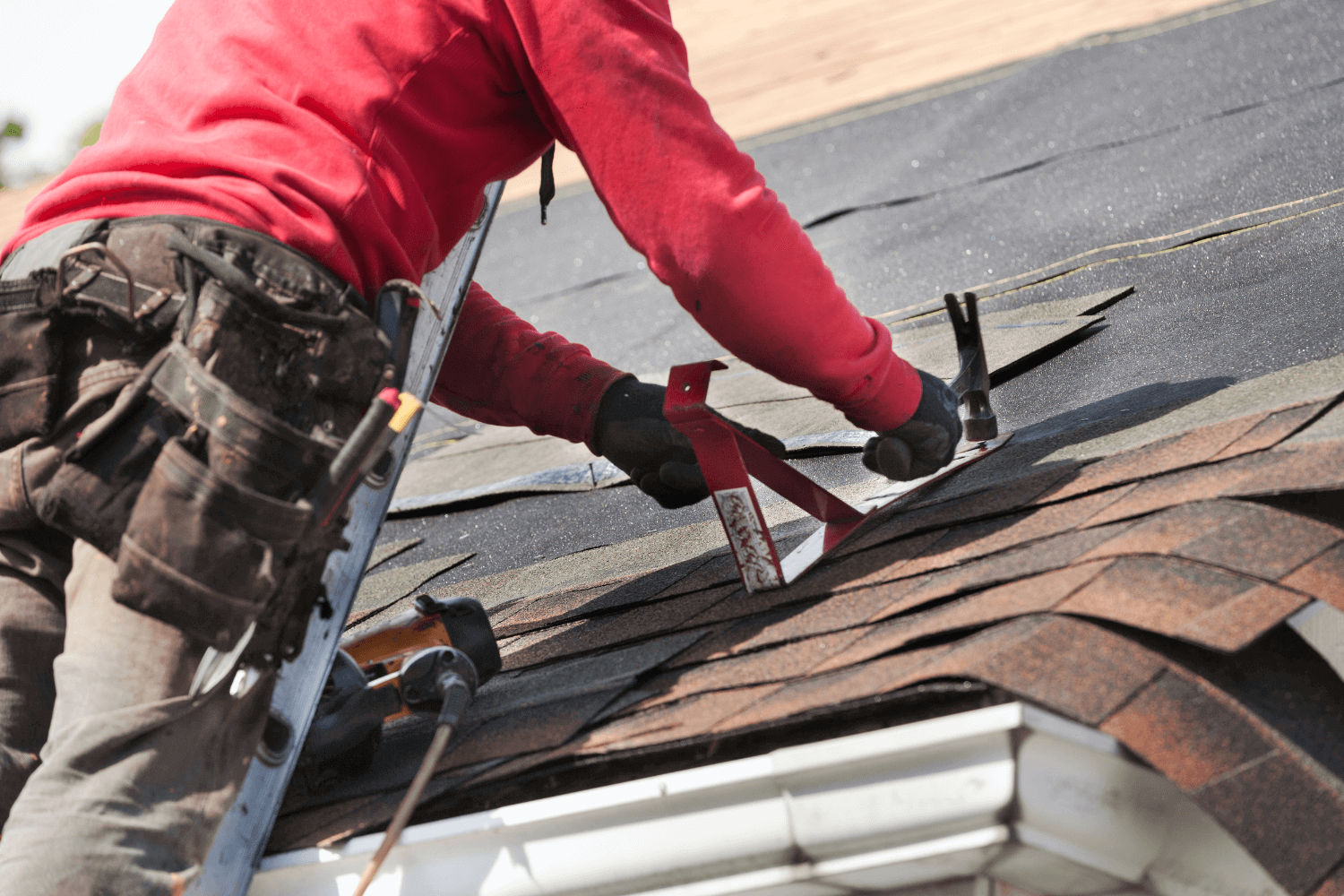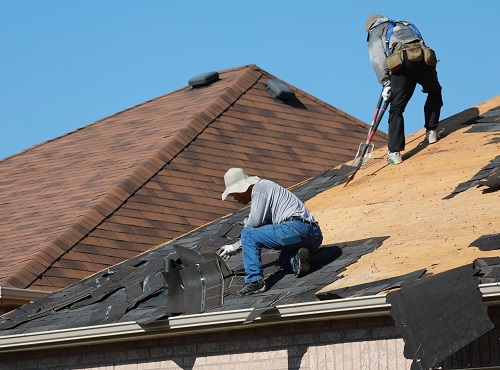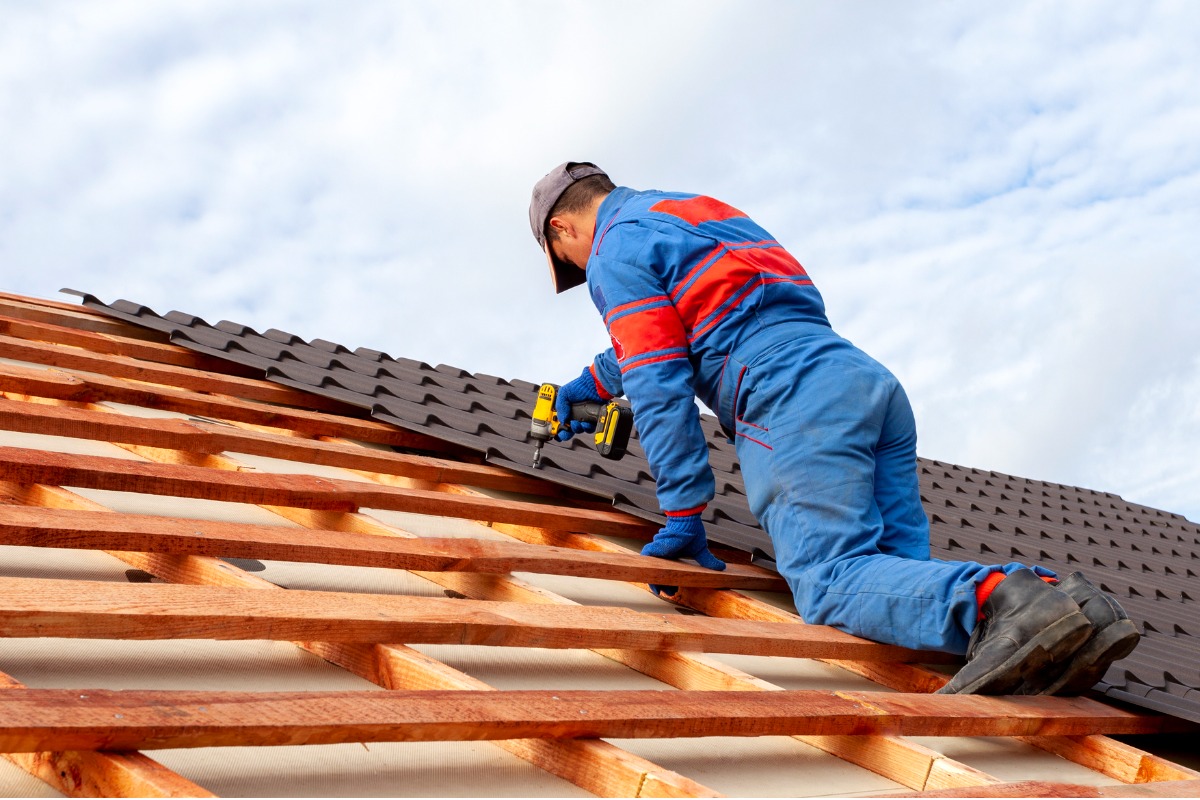The Risks of Overlooking Roof Repair Is Never Worth It
Wiki Article
Indicators You Required Roof Fixing: Protect Your Investment With These Easy Checks
Understanding the signs that indicate a requirement for roof covering repair is vital for safeguarding your residential or commercial property and financial investment. Common indicators such as missing shingles, unexpected water discolorations, and granules building up in rain gutters can suggest underlying concerns that, if left unaddressed, may rise into even more severe issues. Furthermore, signs like drooping areas or enhanced power costs can also direct to inadequacies or damages. To ensure your roofing system stays in leading problem and to avoid expensive fixings, it is essential to recognize these early indication and act accordingly. What steps should you take following?Missing Out On or Damaged Tiles
When evaluating the problem of your roofing system, among one of the most telling signs of potential issues is the presence of missing or harmed shingles. Roofing shingles act as the very first line of protection versus the aspects, and their stability is essential for keeping the total health and wellness of your roof - I&E Roofing & Construction, Inc.. A couple of missing tiles may appear minor, yet they can result in significant water seepage, compromising the underlying framework and requiring a lot more substantial repairsHarmed shingles can show up in different means, consisting of curling, splitting, or blistering. Each of these problems can lower the effectiveness of your roofing system, allowing wetness to pass through and cause more extreme troubles. Roofing Service. It is vital to perform regular examinations, specifically after extreme climate events, as high winds and heavy rain can intensify roof shingles degeneration
If you recognize missing out on or damaged roof shingles, it is advisable to resolve these issues promptly. While small repair services may be manageable for a home owner, considerable damage typically requires specialist intervention. Timely action can stop more complications and protect your investment, making certain the longevity and efficiency of your roofing system.
Water Discolorations on Ceilings
Water discolorations on ceilings are typically clear indicators of underlying water damage that needs immediate focus. Identifying the source of these discolorations is important, as they can result from numerous problems, consisting of roofing leaks or pipes problems. Attending to the origin not only protects against more damages yet also secures the honesty of the home.Recognizing Water Damage

When inspecting for water stains, take note of both the size and form of the staining. Irregular shapes might suggest recurring leakages, while much more defined locations might indicate previous issues. Additionally, think about the location of the stains; discolorations near pipes components or outside wall surfaces might give ideas about potential resources of the water intrusion.
It is additionally crucial to take a look at the appearance of the ceiling surrounding the discolorations. Peeling paint or bubbling drywall can signify substantial moisture direct exposure, warranting prompt focus. Regular evaluations and timely activity can help prevent a lot more extreme water damages, shielding both the structural stability of the home and the investment it stands for. Constantly get in touch with an expert for a thorough analysis if you find water spots on your ceilings.
Reasons of Discolorations
What variables add to the appearance of spots on ceilings? Water stains, typically showing up as tarnished spots, are mostly triggered by leakages in the roof or pipes systems - I&E Roofing & Construction, Inc.. When moisture penetrates via roof products or jeopardized pipes, it can build up and cause visible discoloration on ceilingsOne common cause is damaged or missing out on shingles, which can enable rain to permeate right into the attic and, eventually, to the ceilings below. Additionally, incorrect blinking around chimneys, vents, or skylights can be a substantial resource of water invasion. Plumbing leakages, whether from defective pipes or overruning fixtures, can likewise develop spots, especially in locations straight listed below washrooms or kitchen areas.

Determining the source of the discolor is essential for efficient repair. Disregarding these signs can result in much more comprehensive damages, consisting of mold and mildew development and architectural weakening, emphasizing the significance of timely intervention to secure your financial investment.
Granules in Gutters
During routine inspections of your seamless gutters, the presence of granules can be a considerable sign of roofing system degeneration. These little, sand-like fragments are generally discovered on the surface area of asphalt roof shingles, acting as a protective layer versus UV rays and weathering. Gradually, deterioration can trigger these granules to remove, causing a variety of issues that might endanger the honesty of your roofing system.If you notice a build-up of granules in your gutters, it is vital to take this sign seriously. The loss of granules might expose the underlying asphalt to the components, enhancing the risk of leakages and water damage. This circumstance not just jeopardizes your roofing's life expectancy yet can also result in pricey repair services otherwise resolved without delay.
To minimize prospective damage, it is recommended to evaluate your roofing frequently, particularly after serious climate events. In addition, engaging an expert professional roofer to evaluate the problem of your shingles can give important understandings. Early treatment is key to preserving your investment and making certain the longevity of your roofing system. Remember, granules in gutters are not a trivial issue; they signal the need for immediate attention and possible repair.

Sagging Roof Areas
Sagging roof locations can show severe structural issues that require prompt interest (Roofing Service). Noticeable deformities on the roof's surface, combined with the presence of water stains inside the home, are important indication that should not be forgotten. Resolving these issues quickly can protect against more damage and pricey fixingsNoticeable Roofing Deformities
How can homeowners identify possible problems with their roofing systems? One of one of the most telling signs is visible roofing deformities, especially sagging locations. A sagging roofing system may show up as dips or curves, showing underlying architectural issues that could endanger the stability of the whole roof covering system. House owners should carry out normal assessments, searching for any obvious irregularities in the roofline.
A number of factors can add to noticeable deformities, consisting of water damages, incorrect installation, or the weight of gathered snow and particles. If a roofing system shows up to droop, it might be a sign of weakened rafters or trusses, which can cause more extreme issues if left unaddressed. A drooping roof not just jeopardizes the structural security of the home however can also cause costly repair work costs if the problem escalates.
If sagging or other noticeable deformities are observed, it is advisable to seek advice from an expert professional roofer. They can analyze the circumstance, determine the root cause of the sagging, and suggest ideal repair options. Timely intervention is important to protect your investment and ensure the long life of your roofing system.

Water Stains Inside Home
The visibility of water stains inside the home commonly indicates potential problems with the roof, specifically in areas where sagging has been observed. These discolorations usually show that water is penetrating via the roof covering product, which can result in considerable architectural damage if left unaddressed. Drooping roof covering locations may be triggered by a selection of elements, consisting of inadequate support, collected dampness, or the damage of roofing materials.When you see water discolorations, it is crucial to examine the resource of the wetness. Seek indications of sagging in the roofing system framework, as this can aggravate the problem. Often, sagging locations can trap water, causing leaks and additional damage. Additionally, it is important to examine the age of the roofing; older roofing systems are a lot more vulnerable to put on and tear, increasing the probability of leakages.
Motivate activity is needed to minimize damages. Speak with a certified roof expert to examine the scenario and recommend proper repairs. Ignoring water spots and drooping can lead to costly repair work and compromise the stability of your home. Secure your financial investment by dealing with these indicators prior to they intensify into much more serious problems.
Enhanced Energy Costs
An unanticipated spike in power costs can often signify underlying problems with your roof. When your roof covering is endangered, it can lead to substantial air leakages, permitting conditioned air to get away and unconditioned air to penetrate your home. This ineffectiveness forces your heating and cooling systems to work harder, resulting in enhanced energy intake and higher energy costs.One typical perpetrator is harmed or missing shingles, which can expose your home's interior to the elements. Furthermore, insufficient insulation as a result of roof damage can add to power loss. If you observe a constant surge in your power costs without an equivalent change in usage habits, it is essential to check out prospective roof-related issues.
Routine roof evaluations are necessary for identifying problems before they intensify into expensive repair work. Try to find visible indications of wear, such as drooping areas, fractures, or gaps. These might indicate that your roofing system is no more offering the necessary barrier against the elements. Resolving these problems quickly can assist recover your home's power efficiency and shield your investment in the future. If you presume a problem, speak with a roofing expert for a complete examination.
Mold or Mildew Growth
Mold or mildew development on your ceiling or walls can be a clear sign of roof-related problems, specifically when moisture infiltrates your home. These fungi prosper in moist environments and can present major wellness threats, consisting of respiratory problems and allergic responses. Their existence usually recommends that your roof might be endangered, allowing water to permeate in through leakages or voids.To examine the circumstance, seek dark places or discoloration on surfaces, normally in areas close to the roofline or where water may gather (St Louis Roofing Companies). In addition, check for any type of water spots, peeling off paint, or soft places in your ceiling or wall surfaces, which may suggest ongoing wetness issues
If you observe mold and mildew or mold, it is critical to act quickly. Not only can continued moisture damages your home's architectural integrity, but it can also cause pricey repair work down the line. Involving an expert roofer can aid identify the resource of the problem, whether it's harmed tiles, improper air flow, or various other problems. Regular assessments and upkeep can aid avoid mold growth and protect your investment, making sure a secure and healthy and balanced living setting.
Age of the Roof covering
Reviewing the age of your roofing is important in determining its I&E Roofing & Construction total problem and possible demand for repairs. Many roof materials have a particular lifespan, typically varying from 15 to thirty years, depending on the kind of material used. Asphalt tiles, for example, generally last about 20 years, while metal roof coverings can withstand for 40 years or even more. As roofings age, they become extra vulnerable to harm from weather, parasites, and other ecological elements.Regular assessments are very important for roof coverings older than 15 years. Indications of wear, such as fractured or curling shingles, missing floor tiles, or rust on steel surface areas, indicate that your roofing might need instant focus. Furthermore, internal signs and symptoms like water discolorations on ceilings or wall surfaces can indicate underlying issues connected to an aging roofing.
If your roofing system is approaching its expected life-span, think about getting in touch with a professional roofing contractor for an extensive assessment. They can give understandings on repair work choices or recommend a substitute if needed. Proactive monitoring of an aging roofing can prevent costly damages to your home and assurance that your financial investment stays protected.
Often Asked Concerns
How Often Should I Check My Roofing System for Damages?
Regular roofing system inspections are crucial for preserving the honesty of your home. It is recommended to evaluate your roofing system at the very least two times a year, preferably in the springtime and loss, to identify any kind of possible issues beforehand. Furthermore, after extreme climate events, such as hefty tornados or hail storm, a detailed evaluation is recommended. Addressing small damages immediately can protect against costly repair work and expand the life expectancy of your roof significantly.Can I Fix My Roof Myself?
While it is possible to repair your roof on your own, it is important to evaluate your skills and the intricacy of the damage. Minor problems, such as changing a couple of shingles, may be manageable for a do it yourself enthusiast. Significant fixings or structural concerns frequently require specialist competence to ensure safety and conformity with structure codes. Always prioritize your safety and security and consider consulting a roofing professional for extensive damage or if you are uncertain concerning the fixings.What Are the Typical Sources Of Roofing Leaks?
Typical sources of roofing system leakages include harmed roof shingles, which can occur because of age or severe climate, and improperly sealed vents or blinking that may permit water penetration. Furthermore, clogged up seamless gutters can bring about water backup, leading to leakages. Architectural concerns, such as drooping roofs or jeopardized underlayment, additionally add to this problem. Regular evaluations and upkeep are necessary to determine these susceptabilities and protect against pricey damage to your residential property.Exactly How Can I Pick a Trusted Roof Contractor?
Selecting a trusted professional roofer includes comprehensive study and assessment. Begin by looking for suggestions from relied on sources and inspecting on-line testimonials. Verify the service provider's licensing, insurance coverage, and experience in roof covering projects similar to yours. Demand detailed quotes and contrast them for openness. Additionally, ask about warranties and post-installation assistance. A credible specialist ought to communicate plainly and demonstrate professionalism and reliability throughout the process, guaranteeing your investment is well shielded.What Is the Typical Lifespan of Various Roofing Materials?
The average lifespan of roof covering materials differs considerably. Asphalt tiles normally last 15 to thirty years, while steel roofings can endure 40 to 70 years. Timber trembles typically have a lifespan of 20 to 40 years, whereas clay or concrete tiles can go beyond 50 years with proper upkeep. Finally, artificial roof covering materials might offer longevity similar to traditional options, often enduring 30 to 50 years. Recognizing these life-spans help in preparing for maintenance and replacement.Report this wiki page